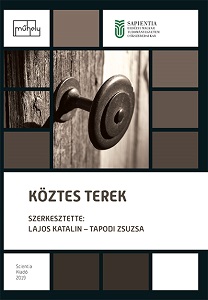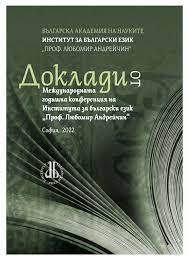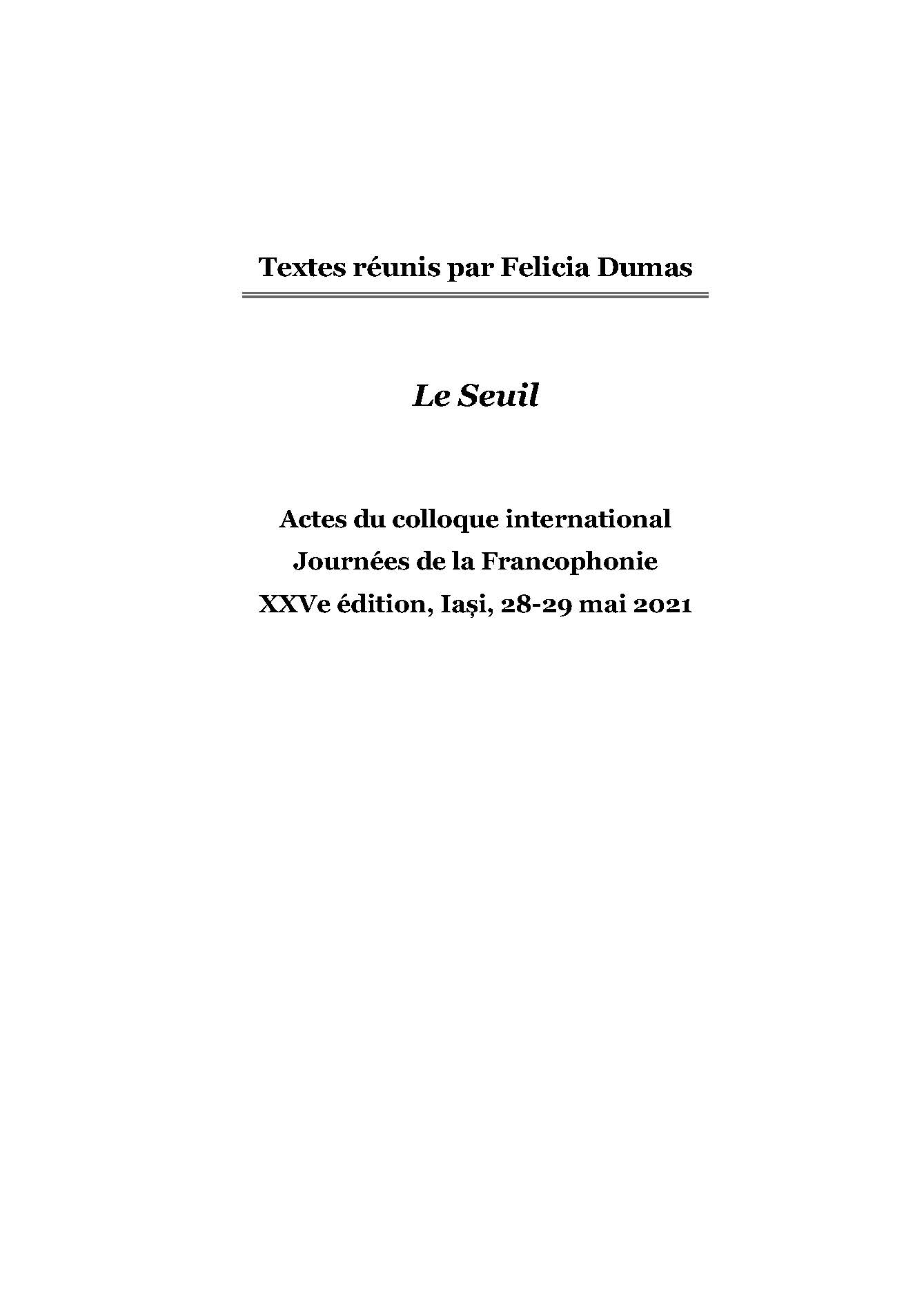
We kindly inform you that, as long as the subject affiliation of our 300.000+ articles is in progress, you might get unsufficient or no results on your third level or second level search. In this case, please broaden your search criteria.




As a bright marker of the author’s idiolect, the оccasionalisms in the rhythmic and narrative works of Stoyan Mihaylovski are original and colourful verbal representations of the author’s insights, emotions and sociopolitical assessments. In the present study 32 hapax legomena and rare words have been lemmatized and analyzed in alphabetical order – from letter N to letter Yа. They have been excerpted from several Stoyan Mihaylovski’s works. Тhese lexemes have been compared with more than 40 Old Bulgarian, Middle Bulgarian and Modern Bulgarian and Russian texts (originated in the XI–XX century) to highlight their originality. Criteria for this analysis are: morphemic structure, denotative and connotative semantics, word formative ways, stylistic scope of use, their synonym corelats and the diffusion of occasionalisms in the Modern Bulgarian language.
More...
In the text I report on documents from the personal archive of the writer Hristo Gerchev, stored in the State Archives - Shumen, related to the history of the Bulgarian literary language. The most important of them is the letter I read from 1910 from Prof. Benyo Tsonev to his student Hristo Gerchev.
More...
The article presents the names pop / papa / papas of Christian religious persons included in the anthroponymy of the Christian population of Nevrokopska Kaza, according to data from Ottoman tax registers from the 16th century. A comparison is made with material from Ottoman registers for Western Thrace and the Southern Rhodopes. A name of domestic, Bulgarian origin, pop is the most widespread in the lists of the Nevrokop region.
More...
Absract. The paper examines some rare dialectal lexemes in Bulgarian dialects in Albania, tracing their correspondences in Slavic and Balkan languages. Some names of animals are considered – vèshk’e, trəmka, as well as names of watery areas – mochvàr, tùn’a, kal and names related to the natural phenomenon of rainfall // snow.
More...
The dialect of the village of Rechane spoken in the Prizren region bears all the diagnostic traits of the Bulgarian language and its northwestern dialects in particular. The geographical location of the dialect in the westernmost part of the Bulgarian language area not only makes it important for the delineation of its western boundary but also provides major evidence of its continuity. This is so especially as the dialect has a number of features typical of the Eastern Bulgarian dialects found at all linguistic levels. The subject of research in this article are specifically these characteristics. The analysis is based entirely on new dialect material collected by the author during the conduction of preparatory courses for university entrance exams in Bulgarian language, literature, history and culture for the local Bulgarian minority during the period 2015–2019. The characteristic dialect features are compared with similar phenomena in the Bulgarian language area and with phenomena in other neigbouring Slavic languages. The author draws important conclusions concerning the ethnic identity of the local population and the unity of the Bulgarian language, the continuity of the Bulgarian language area and the location of its western boundaries.
More...
The study examines Bulgarian settlement names included in the Bulgarian Toponymic Dictionary’s lexicon, which represent the biggest share of all the dictionary entries. It aims at summarizing the structural types of oikomyms that are to be found in the contemporary Bulgarian oikonymic system. Special attention is also given to names of abandoned or depopulated settlements, whose number is constantly growing, since they continue to be part of the Bulgarian oikonymy. The oikonymic classification proposed here is based on the one traditionally implemented in Bulgarian toponymic research. In the conclusion, the most common structural types of settlement names as well as the most frequent formants are presented.
More...
The paper offers etymological interpretation of several Bulgarian dialect words borrowed from neighboring Balkan languages (Turkish and/or Romanian). One of the borrowings is already included in the Bulgarian Etymological Dictionary (ферфельì m. ‘a clumsy person’), while the etymology of the others is explained for the first time (хамел ‘glutton’, хамѐль ‘a gluttonous, voracious person’, хамеллѝкь ‘gluttony’, амѐл ‘a gluttonous, voracious person, cattle, etc.’, ‘stubbornness, persistence’, амѐль ‘greed’ and their derivatives). The paper discusses a couple of issues concerning the etymologization of Balkan borrowings in the Bulgarian dialects such as establishing the contact language, finding the correct etymon in the source language, revealing the specific way of penetration of the borrowings. In order to overcome the difficulties, the research needs to consider the specific sociolinguistic situation, the peculiarities of the dialect phonetic systems, as well as possible phonetic and semantic changes in the source language.
More...
The article attempts to etymologize the dialect noun хрàски ‘small unripe cabbages’. In order to explore possible paths of semantic development, the noun is associated with the verb хрàскам ‘hit hard with noise’. The paper illustrates how hypotheses about the etymology of a word of obscure or uncertain origin can be built by means of semantic parallels. It demonstrates how the recurring links between two meanings, often found in different, etymologically unrelated words, can be convincing proof of the origin of words with obscured etymologies.
More...
Traditionally, calendar time is viewed as a cyclic notion, which predetermines the existence of transitional periods serving as mythological and factual boundaries. In the majority of cases, these periods have negative symbolism as they are characterised by disturbance in the balance between heaven and earth, between the forces of cosmos and chaos. For these reasons, the periods of transition are regarded as dangerous and impure. The study titled “The Naive Axiology in the Bulgarian Folk Calendar” deals with a group of terms in Bulgarian calendar terminology – chrononyms denoting those periods and days in the Bulgarian folk calendar, which represent the most unfavourable time of the year according to folk beliefs. The paper addresses chrononyms formed with the roots: wolf – Вълчи празници (Wolf holidays), mouse – Миши празници (Mouse holidays), rabbit – Зайковден (Rabbit day), snake – Зъмски ден (Snake day), bear – Мечкин ден (Bear day). The semantic analysis studies each chrononym in the context of the system of holidays, prohibitions and preventive actions.
More...
The fragment of the linguistic picture of the world, revealing the physical and mental status of the Bulgarians, is widely presented in the lexical and phraseological fund of the Bulgarian language. The aim of the article is to analize the representation of the concept of health in the Bulgarian language and some of the linguistic and cultural dimensions of health related to the traditions and practical experience of native speakers of the Bulgarian language. The material used in the research was excerpted from dictionaries, collections of proverbs and sayings, archives and conducted associative questionnaires.
More...
The publication discusses the updating of linguistic issues. This research process comes down to a change in the approaches and methods of analysis of linguistic facts. Sometimes this leads to the denial of authoritative theories and the emergence of new schools and directions of linguistic thought. The updating of linguistic issues is a necessary condition for the development of linguistics and its gradual convergence with other human sciences.
More...
This is an attempt to explain the eternal problem of body and soul and its substance, beginning and destructive end of the writing sign – and way to understand the personal strategies to explain the scientific rools. As remark of Derrida’s „L’Аutre cap“ (1991), „Apрorien“ (1998), „Apocalypse“ (1985), „L’ecriture et difference“ (2007) and „Grammatologie“ (1967), the author offers his thesis on Type and Similarity as personal choice as selfanalytic discourse. He makes a step on penetrating once again into the sense and reasons for the Tуpe, especialy for the Glagolitic beginning and Cyrillic continuation. Bringing an observation, V. Rainov for the first time sets to work in a complete general linguistic – psychological, neuropsychological and philosophical knowledge about human language in the Neolinguistic paradigm.
More...
The aim of the paper is to make a comparative analysis of the number of the defective nouns singularia tantum in both Slavic languages – Bulgarian and Slovak, to trace and establish parallels, but also inconsistencies in this language area and to draw conclusions.
More...
The article presents a comparative analysis of the speech genre of political discourse – the president’s New Year’s address to the people. New Year’s address is characterized as a ritual genre and is considered in the linguopragmatic aspect. The features of the ritual political discourse reflected in the speech genre of the New Year’s address are studied. A typology of communication strategies relevant to the presidential discourse in the New Year’s address is proposed. The linguistic features of the implementation of strategies and tactics of the communicative interaction of the president with the people in the New Year’s address are indicated. The New Year’s speeches of the presidents of Bulgaria, Slovakia, Poland, Ukraine and Russia presented on New Year’s Eve 2022 are analyzed.
More...
The paper presents BulFrame – a web-based system designed for creating, editing, evaluating and viewing conceptual frames. A unified theoretical model for the formal presentation of conceptual frames has been developed, which predetermines the architecture of the application for data processing. The conceptual frame defines a unique set of syntagmatic relations between verb synonymous sets representing the frame and synonymous sets of nouns expressing the frame elements. In this way, the structure of the conceptual frame combines and builds on the semantic knowledge presented in WordNet and FrameNet.
More...
Like the myths, the tales challenge our spirit and a worldview historically based on materialism, on the philosophy of the excluded third, on linear temporality and on submission to the laws of causality. The fairy tales, and this Romanian one in particular - Youth Without Age and Life Without Death -, offer us a way out of our customary reductionism, allowing a holistic and metaphysical approach in the broadest sense. What makes the originality, if not the uniqueness, of this tale is that we are dealing with a triple threshold, or rather with three thresholds.
More...
Written in French and Romanian, Vintilă Horia’s autobiographical work dedicates an important amount of space to the recounting of dreams: memorable nocturnal dreams, as well as poignant daytime reveries of the self that tells of itself are transcribed, often commented upon and interpreted. The writer pays extreme attention to signs, that is to say, in baudelairian terms, to the forest of symbols he traverses. On the other hand, the experience of exile and wandering, so painful to the author, have elevated the Home Country, in his view, to the status of an absolute, mythical and heavenly place, and thus have created inside his subconscious a parallel geography of the world. However, sometimes, this particular type of experience, which is situated on the plane of the “imaginal world” (Henri Corbin), increases in intensity with lightning speed: a certain oneirical threshold is crossed without warning; and then we readers find ourselves, in the company of the subject expressing himself but also through him, immersed in the midst of a visionary space. These are some of the most important aspects that we aim to briefly analyse in this paper, browsing through a remarkable autobiographical body of texts, comprising some 1500 pages, that this great exile and Goncourt winner (1960) has left behind.
More...